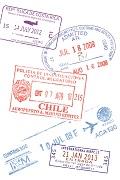
 On Opening Day 2014, there were 224 foreign-born players on Major League Baseball’s 25-man rosters, including players on the disabled list. These diverse players comprise 26.3 percent of all players on Opening Day rosters and include the best players in the league, such as Joey Votto (Canada), Yasiel Puig (Cuba), Albert Pujols (Dominican Republic), Ichiro Suzuki (Japan) and Miguel Cabrera (Venezuela). Although the players who make MLB Opening Day rosters are the world’s most talented baseball players, if they are born outside the U.S. and want to play major league ball, they need to go through the visa process just like every other foreign worker.
On Opening Day 2014, there were 224 foreign-born players on Major League Baseball’s 25-man rosters, including players on the disabled list. These diverse players comprise 26.3 percent of all players on Opening Day rosters and include the best players in the league, such as Joey Votto (Canada), Yasiel Puig (Cuba), Albert Pujols (Dominican Republic), Ichiro Suzuki (Japan) and Miguel Cabrera (Venezuela). Although the players who make MLB Opening Day rosters are the world’s most talented baseball players, if they are born outside the U.S. and want to play major league ball, they need to go through the visa process just like every other foreign worker.
Proper documentation is necessary for all athletes going out of, or coming into, the United States. Even youth sports teams must adhere to a few bedrock principles in U.S. immigration and customs laws, rife with exceptions that account for special situations for distinct groups of people. There are government-sanctioned policies and procedures for facilitating travel of young athletes with their respective teams to foreign destinations. While the process is relatively painless for adult athletes (who often have left the country before and own all the necessary documentation), special requirements and procedures are necessary for travel of minors, especially if it is their first time leaving the U.S.

As a general rule, any U.S. citizen looking to travel outside the US will need a valid U.S. passport—the internationally recognized travel document that denotes a bearer’s identity and citizenship. All minors (under the age of 16) must apply in person at their local government or municipal agency office to fill out a Form DS-11: Application for a U.S. Passport. This is available online or at any municipal office, as well as at post offices.
There is a host of required documents to fill out the DS-11 form, only one of which must be furnished. The easiest route is to use a previously issued, undamaged U.S. Passport or a certified birth certificate issued by the city, county or state in which the individual was born. Additionally, one would need a passport photo in accordance with size requirements denoted on the DS-11 form. Once children become old enough to drive, a driver’s license can provide essential documentation when applying for a passport and make this process easier.
Those born outside the US may provide one of the following: a Consular Report of Birth Abroad or Certification of Birth, a Naturalization Certificate, Certificate of Citizenship. For non-US citizens, the United States Citizenship and Immigration Services (USCIS) has provided that U.S. Lawful Permanent Residents (LPR’s) can continue to use their permanent resident card (Form I-551) or other valid evidence of permanent residence status for international travel.

The DS-11 can only be submitted by a parent or legal guardian of an applicant who is a minor. Sports agencies, coaches, teammates or other supporting team members may not apply on an applicant’s behalf. The parent or guardian must provide proof of their relationship with the applicant using specific documentation. Finally, both parents must provide consent, authorizing passport issuance for a minor under the age of 16. Then, with the payment of applicable fees (specified on the DS-11) the application may be submitted and the processing can begin. Passports typically take 6-8 weeks to be processed, thus making this a matter for the off-season, to avoid delay at playoff time, where most international travel generally happens. Note that routine passport renewals, which can also be completed by mail within the United States, can be processed in approximately 4-6 weeks from receipt of application. These services can be expedited; however, there are extra fees involved.
Those who are traveling outside the U.S. with their teams should be aware of all documentation required and should act well in advance to secure it. Immigration attorneys can provide invaluable guidance on these matters, and can help event owners and rights holders put together instructions regarding all necessary documentation.
Playing at a Higher Level
Event owners and rights holders who expect to have athletes coming into the U.S. from other countries should know that legally, there are three primary options for gifted athletes who want to play for U.S. sports teams. These may not be applicable to everyone, but they are offered here for those who at some point, may make use of them.
The most common form of documentation is the P-1A visa for “internationally recognized athletes.” According to US Citizenship and Immigration Services, the P visa is reserved for those coming to the U.S. temporarily to perform in athletic competitions, individually or as a team, at an internationally recognized level of performance. The applicant must submit evidence of impressive achievements, and prove that he or she possesses a degree of skill and international recognition that makes him or her stand out from ordinary athletes. The “Creating Opportunities for Minor League Professionals, Entertainers, and Teams through Legal Entry Act of 2006” (“COMPETE Act of 2006”) expanded the P-1 visa to enable amateur and minor league athletes and coaches to qualify.

An individual athlete can apply for an initial period of stay for the amount of time needed to complete the contract, not to exceed five years, and an extension can be filed in increments of up to five years, for a total period of stay not to exceed 10 years. However, the athlete is allowed to return to his or her home country to re-apply for a P-1A visa after the 10th year expires. Furthermore, essential support personnel, such as coaches, scouts, and trainers, are eligible to join the P-1 athlete to perform critical services that cannot easily be provided by a U.S. worker.
Another less common option for baseball players is the O-1A visa for “individuals with extraordinary ability in athletics.” The athlete must submit documentation of sustained national or international acclaim that evidences his or her extraordinary ability. This is a higher standard than the P visa, and requires the beneficiary to establish that he or she is one of a small percentage of people who has risen to the very top of his or her field. The athlete may be granted an initial period of stay up to three years, with extensions of stay in one-year increments.
Finally, for the crème de la crème there is an immigrant visa for permanent residence. The Employment-Based First Preference (EB-1) visa for extraordinary ability is reserved for the elite players within major sports leagues. An athlete petitioner would have to demonstrate extraordinary ability in the athletics through sustained national or international acclaim and provide extensive documentation of recognized achievements in the sport.
Although similar to the O-1 visa, the EB-1 has a much higher standard for the levels of recognition and acclaim that merit permanent residence. Unlike the P-1A visa, the government does not assume that a contract with a major league team necessarily means that the player has extraordinary ability. The athlete would have to provide evidence of his or her statistics, salary, playing time, media coverage, awards, etc. to prove his or her status as being elite.
Naturally, there are complicated issues with each of these visas, which is why agents or teams seeking to bring in foreign-born players are advised to consult an experienced immigration attorney to ensure their star player is able to come to the U.S. for the big game. Despite its sordid history of segregation, Major League Baseball has become a melting pot, and it is thanks to these three visa routes that the game is as exciting and diverse as it today.

